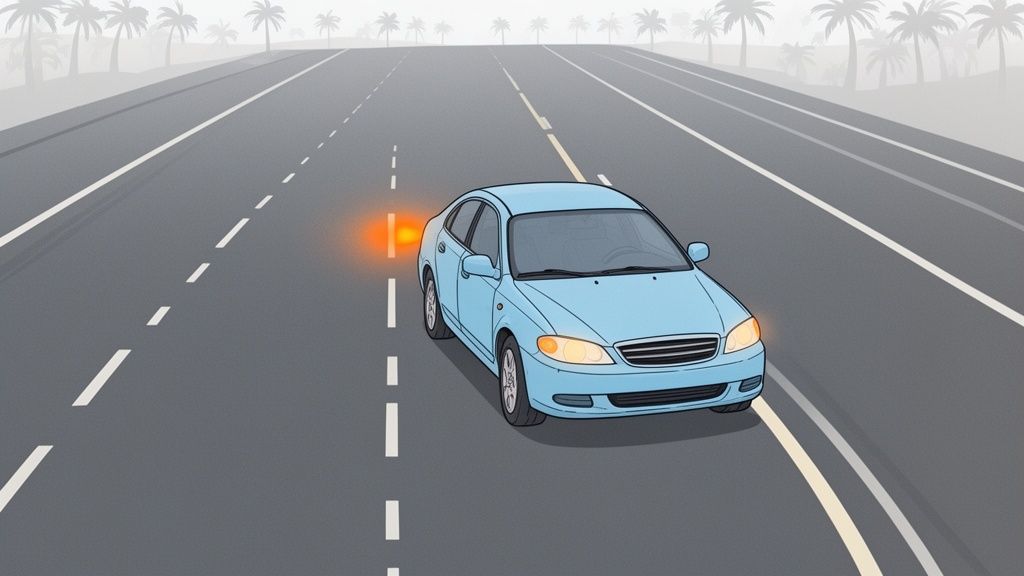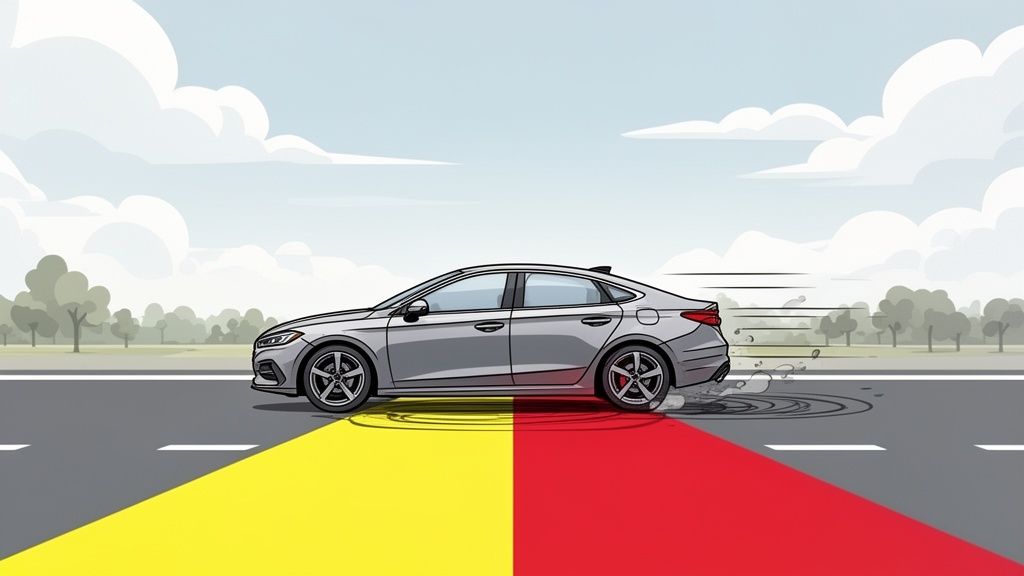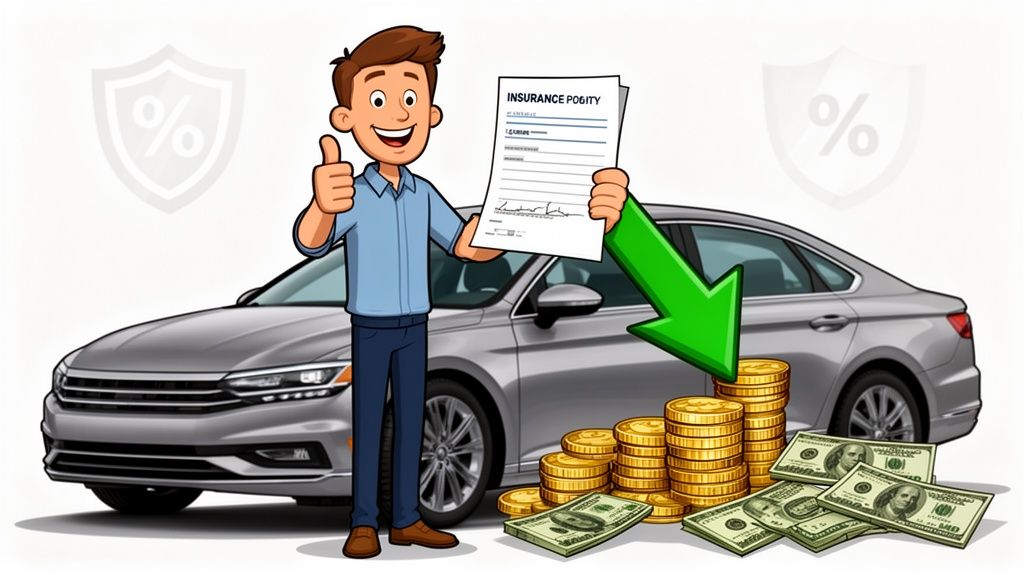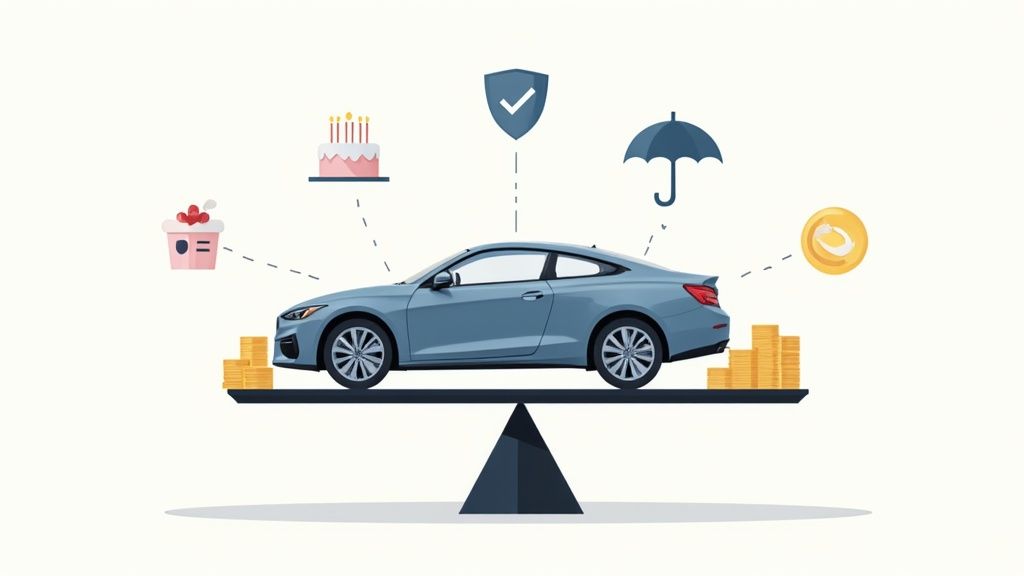If a judge has ordered you to take a driving school course, it can feel a little daunting. However, it’s not just a penalty. Think of it as an educational tool. In addition, it is a chance to refresh your knowledge of traffic laws. It is also a way to sharpen your driving habits to keep everyone safer on the road.
Why Would a Judge Order a Driving Course?
Getting a court notice for a driver improvement course can be confusing. Still, judges have specific reasons for it, and they’re all focused on public safety. It is less about punishment and more about giving you a chance to reset your skills. As a result, the ultimate goal is to prevent any future tickets or collisions.

This idea is not new. In fact, a major safety organization developed the first-ever defensive driving course back in 1964. These programs have a long history of using proven teaching methods. Consequently, they help reduce collisions and injuries. They also serve as a constructive alternative to just fines or points. This helps manage the courts’ busy schedules. For more information on general driving safety, you can visit the National Highway Traffic Safety Administration (NHTSA).
Common Reasons for a Court-Ordered Driving Course
A judge’s decision to send you to a driving course is not made lightly. Usually, it is tied to a specific incident or a pattern of driving behavior. These actions raise a red flag about safety.
Here are some of the typical traffic violations that might lead a judge to require a driver improvement course.
| Violation or Scenario | Potential Consequence Without the Course |
|---|---|
| Accumulating Too Many Points | License suspension or revocation. |
| Serious Traffic Violations | Hefty fines, significant points, or even jail time. |
| At-Fault Collisions | Higher insurance premiums and potential civil liability. |
| Plea Agreement Requirement | Points added to your license and a larger fine. |
Essentially, the court sees the course as a proactive step. It aims to prevent these more severe outcomes. At the same time, it addresses the root cause of the traffic offense. It is a way to ensure you have the knowledge to avoid similar situations. The U.S. Department of Transportation provides excellent resources on safe driving practices for all drivers.
Making Your Way Through Enrollment and Course Completion
When a judge orders you to take a driving course, figuring out what to do next can feel overwhelming. But do not worry, the process is pretty straightforward. Your first move is the most important one. You must find a driving school that is officially approved by the state where you received the ticket.
If you sign up with a non-approved school, the court will not accept your certificate. This means you have wasted your time and money. Consequently, you will have to do it all over again. Therefore, it is vital to stick to the official list of approved providers.
To get registered, you will need a few things handy. Make sure you have your driver’s license. Also, have the citation number from your ticket and any other court paperwork. This information connects your course completion directly back to your traffic violation. This ensures you get the credit you need from the court.
What’s the Course Actually Like?
Whether you decide on an online class or a traditional classroom setting, the material in a court-ordered driving school will be consistent. The whole point is to give you a serious refresher on being a safe, responsible driver.
You can expect the curriculum will cover key topics, including:
- Up-to-date state traffic laws
- Essential defensive driving skills to help you anticipate and avoid crashes
- The serious consequences of driving while impaired or distracted
- How to spot and handle common road hazards before they become a problem
This image really drives home why these courses are so beneficial.

As you can see, completing a driver improvement course isn’t just about satisfying the court. It often leads to fewer traffic incidents. It can even help with your insurance rates.
Once you have worked through all the material and passed the final test, the school will give you a certificate of completion. This is the official proof you need to provide to the court.
Crucial Tip: Keep a close eye on your court-ordered deadline. You absolutely must get that completion certificate submitted before the date the judge gave you. Missing it could lead to much bigger problems, like a suspended license.
Finally, make sure you know exactly how the court clerk wants to receive your certificate. Do they need it mailed, dropped off in person, or can it be sent electronically? A quick call can save you a major headache. It also ensures your case is officially closed out. For more general information on driver safety, reputable sources like the National Highway Traffic Safety Administration (NHTSA) are always a good choice.
What This Means for Your Driving Record and Insurance
Finishing a court-ordered driving school is not just about satisfying a judge’s order. Instead, it is a smart move that can directly benefit your driving record and your wallet. Taking the course shows you are serious about being a safer driver. Both the state and your insurance company take notice of this.

The most immediate impact is on your driving record. Many states use a point system to track violations. If you get too many points, you are looking at a suspended license. The good news is that completing a defensive driving course can often prevent points from being added to your record.
This is a huge deal for keeping your license clean. It also helps keep your driving privileges intact. For a more detailed breakdown, you can read our guide on how to remove points from your driving record.
Getting an Insurance Discount
Now, let’s talk about the money you can save. Insurance companies see completing a defensive driving course as a good sign. To them, you are a lower-risk driver. As a result, you are less likely to get into another collision. They often reward that with a discount on your premium.
This is not just a few cents, either. The savings can be significant over time. To make sure you get this benefit, here is what you need to do:
- Call Your Insurer First: Before you even sign up for a course, give your insurance agent a call. Confirm they offer a discount for a state-approved driver improvement school. Also, ask what the potential savings could be.
- Send in Your Certificate: Once you’ve passed the course, you’ll get a completion certificate. Make a copy and send it straight to your insurance company as proof.
- Check Your Next Bill: Do not just assume the discount was applied. When your next policy statement arrives, double-check that the lower rate is reflected. If not, follow up with them.
Driver improvement schools are used for all sorts of reasons. This includes handling point accumulation and offering refresher courses for mature drivers. It is all about promoting safer roads for everyone.
A Look at Florida’s Specific Driving School Rules
Every state handles traffic laws differently. Florida is a perfect example of a place with a very specific, structured system. Rules from other states will not necessarily apply here. Florida has built a detailed framework for driver improvement. It directly ties the required education to the seriousness of the traffic violation.
This is a smart approach. Instead of a single penalty for everyone, the state tries to correct specific driving behaviors.

This is why you cannot just rely on general advice you find online. For the most accurate, up-to-date rules, your best source is always the official state website. You should visit the Florida Department of Highway Safety and Motor Vehicles website for official information.
Florida’s Tiered Driving Course System
Florida’s system is all about matching the course to the offense. Think of it as a ladder. The more serious the situation, the more detailed the course you will need to take. This is not just about punishment. It is about targeted education to improve safety.
Here is a quick breakdown of how the different levels work:
- 4-Hour Basic Driver Improvement (BDI): This is the one most drivers encounter. If you got a minor speeding ticket or ran a stop sign, this is often the course you can choose to take. It helps keep points off your license. In short, it is a foundational refresher on safe driving habits.
- 8-Hour Intermediate Driver Improvement (IDI): Things get a bit more serious here. A judge might order this course if you have gotten a couple of tickets in a short time. For example, you might get two tickets within 12 months. It is designed for drivers who are starting to show a pattern of risky behavior.
- 12-Hour Advanced Driver Improvement (ADI): This is the most intensive course. It is reserved for major violations. We are talking about situations that lead to a license suspension or revocation. Completing this course is often a required step toward getting your driving privileges back.
This tiered structure shows that the state’s goal is to help drivers. It aims to educate drivers and make the roads safer, not just collect fines. By understanding these different levels, you can learn more about how traffic school online in Florida fits your specific situation.
So, What Will You Actually Learn to Become a Safer Driver?
Let’s be honest, most people sign up for a defensive driving class because they have to, not because they want to. But here is the thing. This is not just about checking a box for the court. A good course is a fantastic chance to seriously improve your skills behind the wheel.
Think of it less like basic driver’s education. Instead, it is more like advanced training. The goal is to move you from being a reactive driver to a proactive one. A reactive driver just responds to what is happening. A proactive driver sees trouble coming and avoids it completely.
Learning to See Dangers Before They Happen
The single most valuable skill you will gain is hazard perception. It sounds a bit technical, but it is simple. It is the art of spotting potential problems on the road long before they become emergencies.
Instead of getting tunnel vision on the car directly ahead, you will learn to actively scan your entire environment. This is not just a quick glance. It is a constant, disciplined process.
- Check your mirrors every 3-5 seconds. This keeps you fully aware of what is happening beside and behind you.
- Look for the unexpected. That could be a kid about to chase a ball into the street, a car door opening, or a driver who looks like they are about to merge without signaling.
- Read other drivers. You will get better at anticipating what others will do. For example, you might spot someone who is clearly distracted or driving too aggressively.
This proactive mindset is a game-changer. It buys you precious seconds to react calmly. As a result, you can turn a potential collision into a non-event. For a full breakdown of the topics covered, you can check out the curriculum for a Florida online driver improvement course.
The core idea you’ll master is managing the “space cushion” around your vehicle. This buffer zone is your best defense. It gives you the room you need to brake or steer clear if another driver makes a mistake.
To give you a clearer picture, here is a quick look at the essential skills you’ll learn. You will also see how they contribute directly to making the roads safer for everyone.
Key Defensive Driving Techniques at a Glance
| Defensive Driving Skill | Why It Matters on the Road |
|---|---|
| The 3-4 Second Rule | Prevents rear-end collisions by ensuring you have enough time to stop safely. |
| Scanning & Situational Awareness | Helps you spot hazards like pedestrians, cyclists, and erratic drivers early. |
| Managing Your Space Cushion | Creates a safety buffer around your vehicle, giving you an “out” in emergencies. |
| Anticipating Others’ Actions | Allows you to prepare for potential mistakes from other drivers before they happen. |
| Controlling Emotions | Keeps you calm and focused, preventing road rage and poor decision-making under stress. |
These are not just abstract concepts. They are real techniques you can start using the moment you finish the course. The U.S. Department of Transportation also has some excellent resources on these fundamental safe driving practices.
Frequently Asked Questions About Court Ordered Driving School
Getting ordered by a court to take a driving class can definitely leave you with a lot of questions. It is a situation most people do not plan for. Figuring out the next steps can feel overwhelming. Let’s clear up some of the most common things people ask.
What is a driver improvement course and who needs it?
A driver improvement course, also called a defensive driving class, is an educational program. It is designed to refresh your knowledge of traffic laws and teach safe driving techniques. Judges often order it for drivers who receive a traffic ticket for a moving violation. It can also be for drivers who have accumulated too many points on their record.
How do points on a driving record affect my insurance?
Insurance companies use your driving record to determine how risky you are to insure. Each point on your record signals a past driving violation. More points usually mean higher risk. As a result, insurers often charge higher premiums to drivers with points. Completing a driver improvement class can sometimes prevent points from being added. This helps keep your insurance rates from increasing.
Do defensive driving classes remove points from your record?
This varies by state. In some states, like Florida, electing to take a defensive driving class can prevent points from being added to your record for a specific ticket. However, it usually does not remove points that are already there from past violations. Always check your state’s specific rules on an official .gov website. The Florida Department of Highway Safety and Motor Vehicles site explains the rules for Florida drivers.
How can I find a state-approved driving school?
Your state’s Department of Motor Vehicles (DMV) or a similar agency will have an official list of approved course providers. You should always check this official list before enrolling. Using a non-approved school means the court will not accept your completion certificate.
What should I do after a minor collision?
First, ensure everyone is safe and move your vehicles out of traffic if possible. Then, exchange information with the other driver, including names, contact information, and insurance details. You should also take photos of the scene and any damage. Finally, report the collision to law enforcement and your insurance company. The Insurance Institute for Highway safety (IIHS) provides helpful resources, especially for new drivers.
Ready to meet your court requirements with a state-approved course? BDISchool offers a convenient, fully online Basic Driver Improvement Course that fits your schedule.





